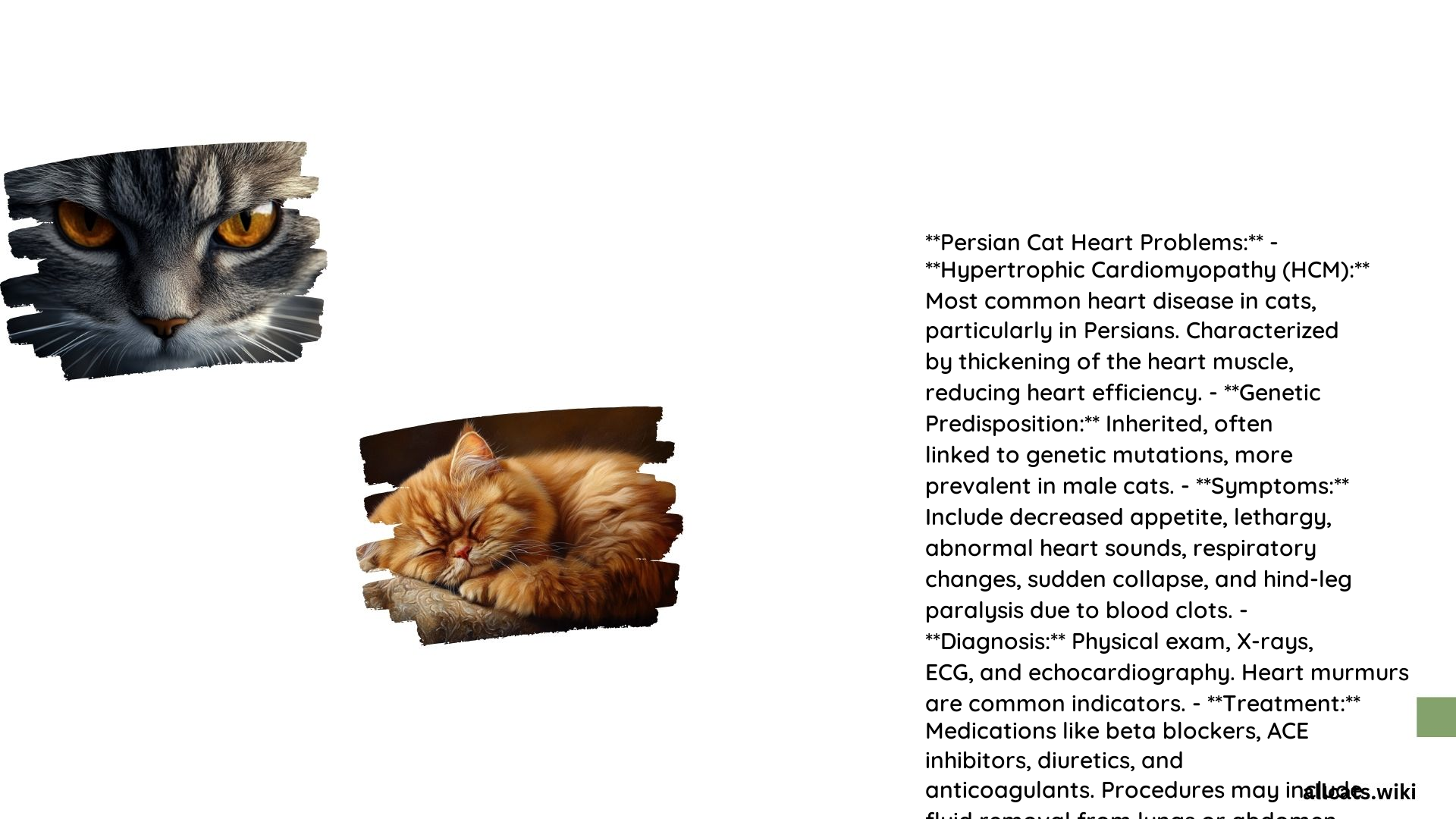Comprehensive Guide on Persian Cat Heart Problems
Persian cats are known for their distinctive appearance, with their fluffy coats and flat faces. However, this breed is also prone to certain health issues, including heart problems. In this comprehensive guide, we will explore the common heart problems in Persian cats, their early warning signs, prevention and management strategies, and the costs associated with veterinary care.
What are the Common Heart Problems in Persian Cats?
Hypertrophic Cardiomyopathy (HCM):
– HCM is the most prevalent heart disease in Persian cats, characterized by the thickening of the heart walls, which can lead to reduced heart function and an increased risk of heart failure.
– The condition is often inherited, making genetic testing important for breeders and owners to identify potential carriers.
– HCM is particularly prevalent in Persian cats due to genetic factors, although the exact prevalence rates can vary.
Dilated Cardiomyopathy (DCM):
– While less common in Persians compared to HCM, DCM involves the enlargement of the heart chambers, leading to reduced heart function.
– However, DCM is not as frequently associated with Persian cats as HCM.
What are the Early Warning Signs of Heart Disease in Persian Cats?
Behavioral Changes and Physical Symptoms:
– Lethargy and reduced activity
– Loss of appetite
– Difficulty breathing, including shortness of breath, rapid breathing, or coughing
– Abnormal heart sounds, such as murmurs or irregular heart rhythms
– Exercise intolerance
– Sudden paralysis due to blood clots
– Bluish discoloration of the pads of feet and nailbeds due to poor oxygen flow
Checklist for Cat Owners:
1. Monitor your Persian cat’s appetite for any decrease in food intake.
2. Observe your cat’s activity levels and note any reduction in activity or playfulness.
3. Check your cat’s breathing for any signs of rapid or labored breathing.
4. Inspect your cat’s physical condition for signs of weakness or lethargy.
5. Monitor your cat’s grooming habits, as changes can indicate an overall decline in health.
6. Schedule regular veterinary check-ups to catch any early signs of heart disease.
How Can You Prevent and Manage Heart Problems in Persian Cats?
Dietary Recommendations:
– Feed your Persian cat a balanced, high-quality diet that meets their nutritional requirements.
– Consider diets formulated for cats with heart disease, such as Royal Canin Renal Support.
Exercise Guidelines:
– Encourage moderate exercise to maintain your cat’s overall health, but avoid strenuous activities that could exacerbate heart conditions.
Regular Veterinary Check-ups:
– Schedule annual check-ups to ensure early detection of any heart disease.
– Learn to monitor your cat’s respiratory rates and other vital signs at home, as advised by your veterinarian.
Supplements and Medications:
– Depending on the condition, your veterinarian may prescribe medications such as beta-blockers, ACE inhibitors, diuretics, anticoagulants, or calcium channel blockers to manage heart disease.
– Follow the veterinarian’s recommendations for dosages and be aware of potential side effects.
When Should You Seek Veterinary Care for Suspected Heart Problems?
When to Seek Immediate Attention:
– If you notice sudden paralysis, difficulty breathing, or collapse in your Persian cat, seek immediate veterinary care.
When to Schedule Regular Check-ups:
– Schedule regular check-ups if you observe any of the early warning signs mentioned above.
Diagnostic Tests:
– Your veterinarian may recommend various diagnostic tests, including echocardiograms, blood tests, chest X-rays, and electrocardiograms (EKG) to evaluate your cat’s heart health.
What are the Costs and Financial Assistance Options for Persian Cat Heart Problems?
Diagnostic Costs:
– Echocardiogram: $500 to $1,500
– Blood tests and X-rays: $50 to $200 each
– Veterinary consultations: $50 to $100 for initial visits, with potentially lower costs for follow-up visits
Treatment Costs:
– Medications: $20 to $100 per month, depending on the type and dosage
– Hospitalization: $500 to $2,000 or more, depending on the duration and level of care
Financial Assistance Options:
– Pet insurance: Consider investing in pet insurance to cover unexpected veterinary expenses.
– Veterinary financing plans: Many veterinarians offer financing options to help manage costs.
– Non-profit organizations: Some non-profit organizations provide financial assistance for pet owners facing high veterinary bills.
Remember, the costs and financial assistance options can vary widely, so it’s essential to discuss your specific situation with your veterinarian.
References
- Animergevets. (n.d.). Hypertrophic Cardiomyopathy in Cats – A Pet Parent’s Guide. Retrieved from https://animergevets.com/hypertrophic-cardiomyopathy-in-cats/
- PetMD. (n.d.). Heart Failure in Cats. Retrieved from https://www.petmd.com/cat/conditions/cardiovascular/c_ct_heart_failure
- Metrovetchicago. (n.d.). Heart Disease In Cats, Causes, Diagnosis and Treatment. Retrieved from https://www.metrovetchicago.com/services/feline-medicine/heart-disease-in-cats/
- PetMD. (n.d.). Heart Disease in Cats. Retrieved from https://www.petmd.com/cat/conditions/cardiovascular/c_ct_heart_disease
- Untamed. (n.d.). The Persian cat health issues explained. Retrieved from https://www.untamedcat.com/persian-cat-health-issues/

